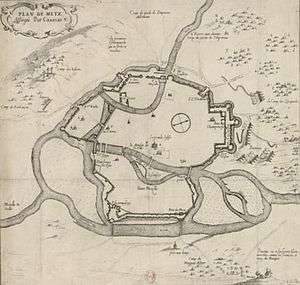Siege of Metz (1552)

The Siege of Metz during the Italian War of 1551–59 lasted from October 1552 to January (1-5), 1553.
The so-called Augsburg Interim came to an end when Protestant princes of the Schmalkaldic League approached Henry II of France and concluded the Treaty of Chambord, giving the free cities of Toul, Verdun, and Metz (the 'Three Bishoprics') to the Kingdom of France. The Holy Roman Emperor Charles V laid siege to the French garrison commanded by Francis, Duke of Guise. Although cannonades destroyed large parts of the fortifications (see fr:Remparts médiévaux de Metz), the Imperial army was unable to take the city and was stricken by typhus, abandoning the siege along with the sick and wounded. Metz remained a French protectorate (fr:République messine) until its annexation was formalized in 1648 by the Treaty of Westphalia. [1]
References
- ↑ Chaunu P. (2000) Charles Quint. Eds. Fayard. ISBN 978-2-213-60394-0 pp. 707–760; Durot E. (2012), François de Lorraine, duc de Guise entre Dieu et le Roi, chap. 4